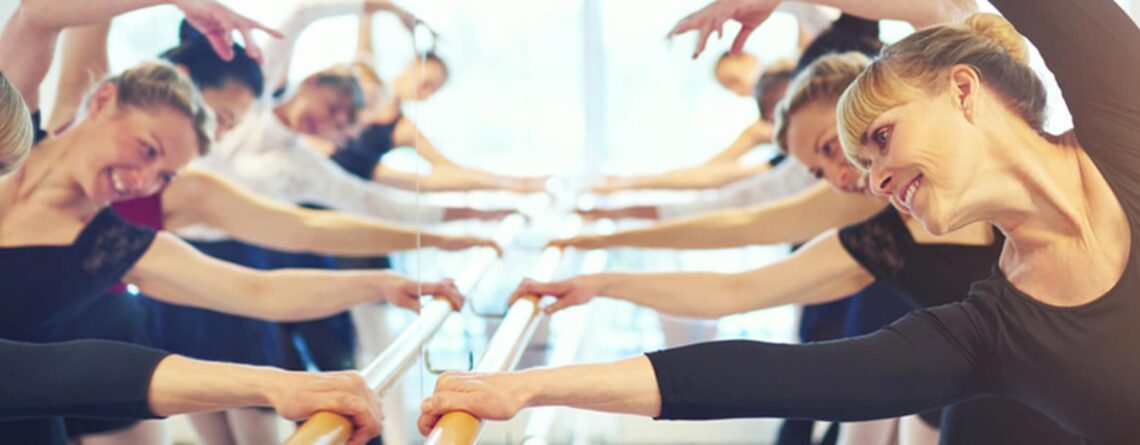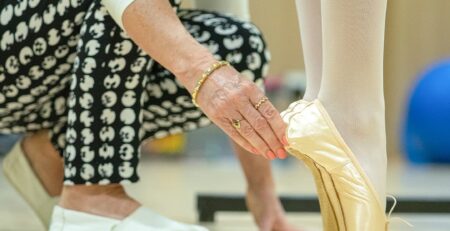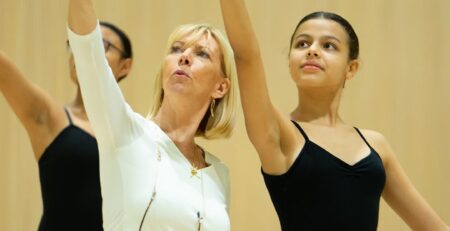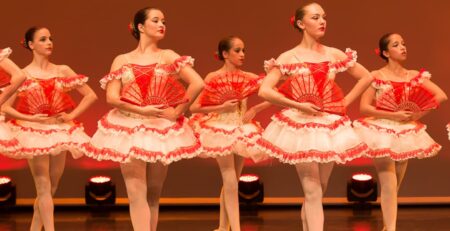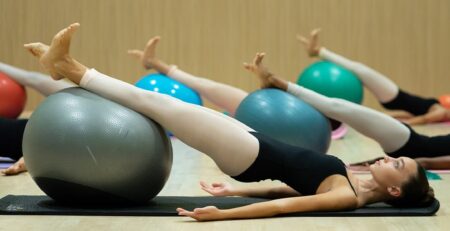Ballet Dance Classes for Beginners: Learn the Fundamentals
Ballet is a beautiful and captivating form of dance that has enthralled audiences for centuries. If you have always been fascinated by the grace and elegance of ballet dancers, you might be eager to learn this classical dance form. Fortunately, ballet dance classes for beginners can help you learn the fundamentals and embrace this mesmerising dance. This blog will explore various aspects of ballet classes, including what to expect and how to prepare for your first class.
Turning Pointe: Beginner Ballet Dance Classes in Dubai and Abu Dhabi
Turning Pointe is a renowned dance school in UAE known for its top-quality ballet classes, offering a supportive and enjoyable environment for beginners. We specialise in beginner-friendly ballet dance classes designed for students from 3yrs up to adults, and these classes teach the basics of ballet in a nurturing and enjoyable environment.
At Turning Pointe, we offer ballet classes based on the Royal Academy of Dance (RAD) syllabus for children aged 3 to 19. Our classes are taught by experienced instructors with professional experience and a strong background in teaching ballet, focusing on proper technique, musicality, and artistry.
All our beginners have the opportunity to perform in our annual recitals and showcases, providing a chance to showcase their hard work and dedication. With smaller class sizes, you’ll receive personalised attention and guidance from the instructor, ensuring a solid foundation in ballet.
Preparing for Your First Ballet Dance Class
Once you have signed up for your beginners class, whether it’s an adult ballet class or a 3yr old starting ballet, here’s what you need to know:
What to Wear to Your First Ballet Class
Comfortable and form-fitting clothing is recommended for ballet classes. Loose clothing can distract the instructor from seeing your movements. Tight clothing will allow the instructor to observe your body alignment and provide necessary corrections. It is also a good idea to check with the dance studio if they have a uniform or dress policy for the classes. Here are some guidelines on what to wear:
- Leotard: A leotard is a one-piece garment that covers the torso and is typically worn by ballet dancers. Leotards come in different styles and colours, but for beginners, wearing a basic, sleeveless leotard in a solid colour such as black or pink is recommended. The leotard should fit snugly but not too tight, allowing easy movement.
- Tights: Ballet tights are worn under the leotard to provide flexibility and support. Tights come in different materials, such as nylon or cotton, and in different colours. For beginners, wearing pink tights that match the colour of your ballet shoes is recommended.
- Ballet Shoes: Soft ballet shoes (not pointe shoes) that are comfortably fitted. Ballet shoes come in different materials, such as leather or canvas, and in different colours. For beginners, wearing pink ballet shoes that match the colour of your tights is recommended.
- Repertoire Skirt (optional): A lightweight skirt worn over the leotard for added elegance and style. Repertoire skirts come in different styles and colours and are optional for beginners.
- Hair: Keep your hair back in a neat bun or ponytail to keep it out of your face. If your hair is too short for a bun or ponytail, use hairpins or a headband to keep it in place.
Physical Preparation
Before attending your first ballet dance class, it is important to prepare physically to prevent injuries and make the most out of your class. Here are some guidelines on how adults and older students can prepare themselves:
- Warm-up: Before starting your class, it is important to warm up your muscles. Light stretching and exercises can help loosen your muscles and prevent injuries. You can warm up at home or arrive at the studio early to warm up before the class.
- Stay hydrated: Bring a water bottle to class throughout the session. Staying hydrated is important to maintain your energy levels and prevent dehydration.
- Arrive early: Arriving early allows you to familiarise yourself with the studio and meet the instructor. You can also use this time to warm up or stretch before the class.
The Fundamentals of Ballet Dance Classes for Beginners
Beginner ballet dance classes typically focus on the following key aspects:
Common Ballet Terms and Vocabulary Every Beginner Should Know
Ballet dance has a rich vocabulary of terms and positions that can overwhelm beginners. Here are some common terms and positions to help you get started:
- Plie: A bending of the knees, often done at the beginning of exercises to warm up and stretch the leg muscles.
- Tendu: A movement where the foot slides along the floor until only the toes remain in contact with the ground.
- Passe: A position where one foot is lifted off the ground and brought to the knee of the supporting leg.
- Développé: A slow and sustained unfolding action of the working leg. Weight placement well over the forefoot of the supporting leg is essential and will help to maintain turnout and control of the pelvis.
- First position: A stance where the heels are touching, and the feet are turned outwards, forming a V-shape.
- Second position: A stance where the feet were shoulder-width apart and turned outwards.
- Arabesque: A position where one leg is extended behind the body while the torso and arms are held in a graceful curve.
Understanding Ballet Posture and Alignment
Posture and alignment are critical in ballet dance, as they promote proper form and prevent injury. Here are some important points to remember:
- Stand tall: Keep your spine elongated and your shoulders relaxed and pulled back.
- Engage your core: Keep your abdominal muscles engaged in supporting your spine and maintaining good posture.
- Turn out from the hips: Turn your legs outwards from the hip joint to achieve the desired ballet stance.
- Keep your feet pointed: Extend your toes and keep your feet pointed at all times unless directed otherwise.
- Avoid leaning or slouching: Maintain a straight line from your head to your toes, avoiding forward or backwards leaning.
Barre Exercises
Barre exercises are essential to beginner ballet dance classes, as they help develop strength, balance, and flexibility. Some common barre exercises include:
- Plies: Bending and straightening the knees in various positions
- Battements Tendus: Sliding the foot along the floor to an extended position and back
- Rond de Jambe: Circling the leg from the front to the side and back
- Frappés: Striking the floor with the ball of the foot
Progressing in Your Ballet Dance Classes
As you attend ballet dance classes for beginners, you will gradually learn more complex movements, techniques, and combinations. Being patient and consistent in your practice is essential, as ballet is a challenging art form that requires dedication and perseverance.
Some tips for progressing in your ballet journey include:
- Attend classes consistently and practice at home to reinforce learning.
- Establish specific, achievable goals to help you stay motivated and focused.
- Request constructive feedback from your instructor to identify areas for improvement.
- Participate in other forms of exercise, such as Pilates or yoga, to enhance your overall strength, flexibility, and body awareness.
- Listen carefully to the instructor’s directions and follow them to the best of your ability.
- Avoid talking or distracting others during class.
- Avoid using your phone during class to prevent distractions and maintain focus.
- Avoid leaving early, as it disrupts the class flow and can disrespect the instructor and other students.
- Pick up any belongings and dispose of trash or water bottles after the class.
Benefits of Ballet Dance Classes Beyond Physical Fitness
Ballet dance classes offer numerous benefits beyond physical fitness. Here are some additional benefits to consider:
- Mental and emotional well-being: Ballet dance can improve mental and emotional health by reducing stress and anxiety, boosting mood and self-esteem, and providing a creative outlet.
- Improved coordination and balance: Ballet dance requires precise movements to improve coordination and balance over time.
- Increased flexibility and strength: Ballet dance can increase flexibility and strength, particularly in the legs, core, and back.
- Discipline and focus: Ballet dance requires discipline and focus on mastering the movements and technique, which can translate to other areas of life.
- Socialisation and community: Ballet dance classes allow one to meet new people, build relationships, and be part of a community of dancers.
Conclusion
The art of ballet holds endless possibilities for those seeking to explore a new world of self-expression, discipline, and grace. With dedicated practice and a solid foundation in the fundamentals of ballet, beginners can embark on a fulfilling journey of discovery and growth. Turning Pointe’s beginner adult ballet classes in Dubai are the perfect opportunity to explore this beautiful art form and discover the grace and elegance within you. And the best part? We’re offering a free trial registration so that you can leap into the ballet world without commitment. So why wait? It is your chance to seize the day and join the Turning Pointe community in discovering the magic of ballet.
Are looking to embark on your dance journey, Turning Pointe provides the best ballet dance classes Abu Dhabi and Dubai. Contact us and register today!


